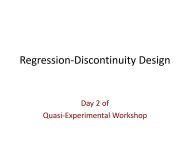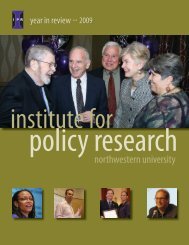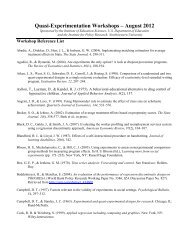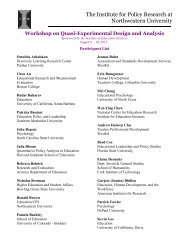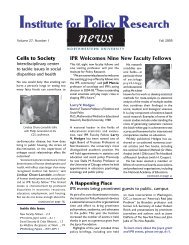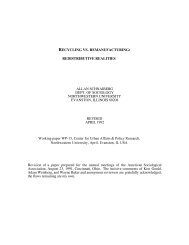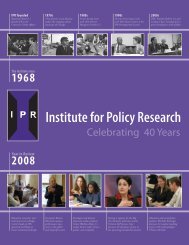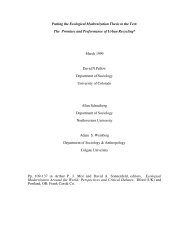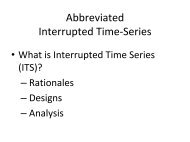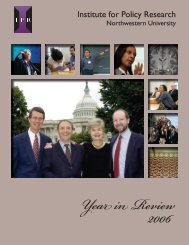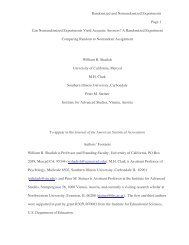Highlights of 2011 - Institute for Policy Research - Northwestern ...
Highlights of 2011 - Institute for Policy Research - Northwestern ...
Highlights of 2011 - Institute for Policy Research - Northwestern ...
Create successful ePaper yourself
Turn your PDF publications into a flip-book with our unique Google optimized e-Paper software.
Child, Adolescent, AND Family Studies<br />
re<strong>for</strong>m. Using CPS data to examine the incomes <strong>of</strong> workingage<br />
Americans from 2005 to 2009 and from 1978 to 1982,<br />
her preliminary findings show that the risk <strong>of</strong> poverty <strong>for</strong> single<br />
adults and single parents compared with that <strong>for</strong> married<br />
couples has remained relatively similar across recessions.<br />
About the Program<br />
Neighborhoods and Health<br />
IPR biological anthropologist Thomas McDade and IPR<br />
developmental psychobiologist Emma Adam were part <strong>of</strong> a<br />
team, led by economist Jens Ludwig <strong>of</strong> the University <strong>of</strong> Chicago,<br />
that was the first to employ a randomized experimental design<br />
to learn about the connections between neighborhood poverty<br />
and health. The researchers studied 4,498 poor women and<br />
children in five major U.S. cities in the Moving to Opportunity<br />
(MTO) residential mobility program, which enrolled low-income<br />
families with children living in distressed public housing. Families<br />
volunteered <strong>for</strong> the experiment, and based on the results <strong>of</strong><br />
a random lottery, were <strong>of</strong>fered the chance to use a housing<br />
voucher subsidy to move into a lower-poverty community.<br />
Other families were randomly assigned to a control group that<br />
received no special assistance under the program.<br />
Published in the New England Journal <strong>of</strong> Medicine, the study<br />
collected in<strong>for</strong>mation on the families who had enrolled in<br />
the program between 1994 and 1998. The research team<br />
measured the heights and weights <strong>of</strong> MTO participants and<br />
collected blood samples to test <strong>for</strong> diabetes. At the time <strong>of</strong><br />
follow-up, 17 percent <strong>of</strong> the women in the study’s control<br />
group were morbidly obese and 20 percent had diabetes. But<br />
low-income women who received the vouchers and moved<br />
with their children to more affluent neighborhoods were less<br />
likely to be extremely overweight or diabetic, revealing better<br />
long-term health outcomes.<br />
School Attendance and Obesity<br />
In a Journal <strong>of</strong> Health Economics article, IPR economist Diane<br />
Whitmore Schanzenbach and her colleagues investigate the<br />
impact <strong>of</strong> attending school on body weight and obesity. As is<br />
the case with academic outcomes, school exposure is related<br />
to unobserved determinants <strong>of</strong> weight outcomes because<br />
some families choose to have their child start school later<br />
or earlier than others. When this factor is unaccounted <strong>for</strong>, it<br />
appears that an additional year <strong>of</strong> school exposure results in<br />
a greater BMI and a higher probability <strong>of</strong> being overweight or<br />
obese. However, when the researchers compared the weight<br />
outcomes <strong>of</strong> similar age children with one versus two years <strong>of</strong><br />
school exposure due to regulations on school starting age, the<br />
significant positive effects disappear, and most point estimates<br />
become negative, but insignificant. However, <strong>for</strong> children not<br />
eating the school lunch, school exposure reduces the probability<br />
<strong>of</strong> being overweight. Additional school exposure also appears to<br />
improve weight outcomes <strong>of</strong> children <strong>for</strong> whom the transition<br />
Diane Whitmore Schanzenbach, Chair<br />
This interdisciplinary program combines the<br />
interests <strong>of</strong> IPR faculty studying the ways in<br />
which social programs, policies, and contexts<br />
affect the lives <strong>of</strong> families and children from<br />
birth to young adulthood. Drawing from the<br />
fields <strong>of</strong> human development and social policy,<br />
psychology, sociology, economics, and law, many<br />
faculty share common interests with scholars in<br />
IPR’s programs on Poverty, Race, and Inequality;<br />
Social Disparities and Health; and Education<br />
<strong>Policy</strong>—particularly in studying the impact <strong>of</strong><br />
public policies on America’s poor.<br />
to elementary school represents a more dramatic change in<br />
environment, such as those who spent less time in childcare<br />
prior to kindergarten.<br />
No Child Left Behind and Obesity<br />
Schools facing increased pressures to produce academic outcomes<br />
might reallocate their ef<strong>for</strong>ts in ways that have unintended<br />
consequences <strong>for</strong> children’s health. For example, the<br />
new financial pressures due to accountability rules might<br />
induce school administrators to try to raise new funds through<br />
outside food and beverage contracts, or schools might cut back<br />
on recess and physical education in favor <strong>of</strong> increasing time on<br />
tested subjects. To examine the impact <strong>of</strong> school accountability<br />
programs, Schanzenbach and her colleagues have created a<br />
unique panel data set <strong>of</strong> elementary schools in Arkansas that<br />
allows them to test the impact <strong>of</strong> the federal No Child Left<br />
Behind Act’s rules on students’ body weights. They find that<br />
schools under pressure from the act have about a 0.5 percentage<br />
point higher rate <strong>of</strong> students who are overweight.<br />
A follow-up survey <strong>of</strong> principals also points to reductions in<br />
physical activity and the use <strong>of</strong> food as a reward and source <strong>of</strong><br />
external funding as potential mechanisms. Understanding how<br />
the school environment might contribute to obesity is key since<br />
school environments are more within the control <strong>of</strong> policymakers<br />
than the family environment.<br />
13



